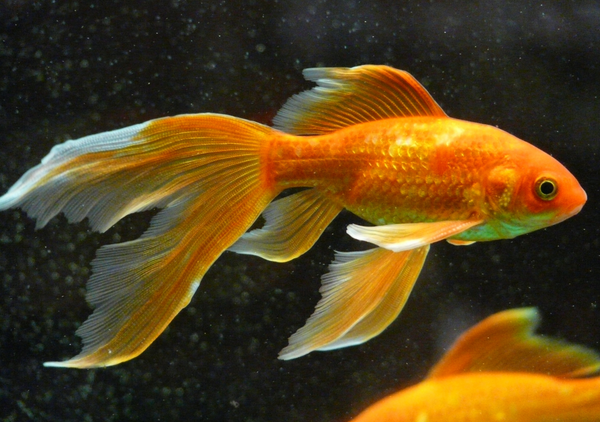Did you know that April is National Frog Month? No, its not a lame April Fools joke, it is 100% true! You probably find yourself asking why are we celebrating frogs? Frogs are an important aspect of our ecosystem, and are a living example of self transformation and harmony. In honor of Frog Month, we're dropping some education on a few of the breeds that we carry here at Pisces!
Poison Dart Frog
 Poison dart frogs are small, brightly colored terrestrial frogs native to Central and South America. Despite being labelled as "poison", dart frogs are not poisonous when kept in captivity. Dart frogs get there toxicity from various ants, roaches and termites found in the wild that cannot be found in captive breeding! Being rainforest dwellers, dart frogs need very high humidity (80%-90%) with a water feature. The most common diet to keep these guys happy is with a colony of flightless fruit flies, as they are too small for crickets. Dart frogs do very will in groups and are a social frog, however it is recommended that you do not mix different species or colors of dart frog in one enclosure. Dart frogs have a nice chirp, and are one of many few diurnal species of frog, meaning they are active during the day!
Poison dart frogs are small, brightly colored terrestrial frogs native to Central and South America. Despite being labelled as "poison", dart frogs are not poisonous when kept in captivity. Dart frogs get there toxicity from various ants, roaches and termites found in the wild that cannot be found in captive breeding! Being rainforest dwellers, dart frogs need very high humidity (80%-90%) with a water feature. The most common diet to keep these guys happy is with a colony of flightless fruit flies, as they are too small for crickets. Dart frogs do very will in groups and are a social frog, however it is recommended that you do not mix different species or colors of dart frog in one enclosure. Dart frogs have a nice chirp, and are one of many few diurnal species of frog, meaning they are active during the day!
Pacman Frog
 Pacman frogs, also known as horned frogs, are round, plump bottom-dwelling rainforest frogs from South America. They get their name from their comically large mouths and circular body shape. They are voracious carnivores, chomping down anything and everything that crosses them, including insects, mice, fish and small reptiles. Pacmans will gorge themselves when food is plentiful to compensate for when food is scarce. Males can grow to be up to 7 inches in diameter! A 15 gallon terrestrial tank is adequate to house a single pacman, NEVER house more than one pacman frog in the same tank! They will benefit from a high level of loose, moist substrate and shady hiding spots. Like most camouflage frogs, they are nocturnal and are active at night. It is normal for a pacman frog to not move for days or months at a time!
Pacman frogs, also known as horned frogs, are round, plump bottom-dwelling rainforest frogs from South America. They get their name from their comically large mouths and circular body shape. They are voracious carnivores, chomping down anything and everything that crosses them, including insects, mice, fish and small reptiles. Pacmans will gorge themselves when food is plentiful to compensate for when food is scarce. Males can grow to be up to 7 inches in diameter! A 15 gallon terrestrial tank is adequate to house a single pacman, NEVER house more than one pacman frog in the same tank! They will benefit from a high level of loose, moist substrate and shady hiding spots. Like most camouflage frogs, they are nocturnal and are active at night. It is normal for a pacman frog to not move for days or months at a time!
Amazon Milk Tree Frog
 Amazon milk tree frogs are as fun to keep as they are downright adorable. In nature they live their lives among the canopy's of the Amazon rainforest. Mating and raising tadpoles in high up water-filled holes in the trees. Milk frogs get their name from the milky secretions these frogs produce from their skin as a first line of defense. For such an interesting and colorful frog, they are surprisingly hardy and easy to care for! Milk Frogs grow quite large, males are ~2 1/2" & females 4". They are not long and lanky like red eye tree frogs, they are more heavy and chubby. A pair of milk frogs can be held in an 18x18x24 tank enjoy a varied diet of appropriately sized crickets and worms. They are gluttonous and hardy eaters, hunting down any food it can scavenge. Unlike the pacman frog, the milk frogs are handle-able and are actually quite docile and relaxed.
Amazon milk tree frogs are as fun to keep as they are downright adorable. In nature they live their lives among the canopy's of the Amazon rainforest. Mating and raising tadpoles in high up water-filled holes in the trees. Milk frogs get their name from the milky secretions these frogs produce from their skin as a first line of defense. For such an interesting and colorful frog, they are surprisingly hardy and easy to care for! Milk Frogs grow quite large, males are ~2 1/2" & females 4". They are not long and lanky like red eye tree frogs, they are more heavy and chubby. A pair of milk frogs can be held in an 18x18x24 tank enjoy a varied diet of appropriately sized crickets and worms. They are gluttonous and hardy eaters, hunting down any food it can scavenge. Unlike the pacman frog, the milk frogs are handle-able and are actually quite docile and relaxed.
Vietnamese Mossy Frog
 These guys are the masters of camouflage! Vietnamese mossy frogs are found in high elevation in flooded caves and off the banks of mountain streams in Vietnam. This species of frog is semi-aquatic, spending a great deal of their time hiding in the water under rocks and foliage. They thrive on an insect diet of appropriate sized crickets, worms and roaches. When putting together your enclosure, it is important to have a large amount of water for them to hide, swim and breed. An 18x18x18 tank is adequate for 2 adult mossy frogs, the females will grow to be ~3" in length. One of my personal favorite traits about these frogs is their various calls and croaks, very cute!
These guys are the masters of camouflage! Vietnamese mossy frogs are found in high elevation in flooded caves and off the banks of mountain streams in Vietnam. This species of frog is semi-aquatic, spending a great deal of their time hiding in the water under rocks and foliage. They thrive on an insect diet of appropriate sized crickets, worms and roaches. When putting together your enclosure, it is important to have a large amount of water for them to hide, swim and breed. An 18x18x18 tank is adequate for 2 adult mossy frogs, the females will grow to be ~3" in length. One of my personal favorite traits about these frogs is their various calls and croaks, very cute!
Pixie Frog
 Contrary to the name, a pixie frog is anything but nimble and light on its feet! A pixie frog is also known an African bullfrog, and gets its confusing name from the Latin genus name Pyxicephalus. Pixie frogs are an olive green with a creamy colour underbelly. They are the 2nd largest species of frog in the world, males can reach up to 10" in diameter! For 1 pixie, a 20 gallon tank is adequate. Like the pacman frog, only 1 should ever be housed due to their tendency towards cannibalism. They should have high humidity (70% and up) and a water dish large enough for the frog to fully submerge itself in. They enjoy worms, crickets roaches, and a mouse every so often. Pixie frogs have a fierce apatite, and should be hand fed unless your looking to get your fingers seriously chomped!
Contrary to the name, a pixie frog is anything but nimble and light on its feet! A pixie frog is also known an African bullfrog, and gets its confusing name from the Latin genus name Pyxicephalus. Pixie frogs are an olive green with a creamy colour underbelly. They are the 2nd largest species of frog in the world, males can reach up to 10" in diameter! For 1 pixie, a 20 gallon tank is adequate. Like the pacman frog, only 1 should ever be housed due to their tendency towards cannibalism. They should have high humidity (70% and up) and a water dish large enough for the frog to fully submerge itself in. They enjoy worms, crickets roaches, and a mouse every so often. Pixie frogs have a fierce apatite, and should be hand fed unless your looking to get your fingers seriously chomped!
Looking for more amphibians? Click Here to view all of our reptile and amphibian care sheets!
Click Here to shop for Frog Month!!!




